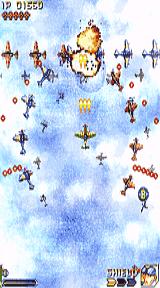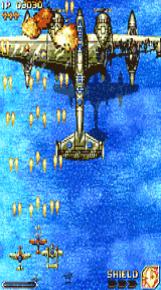|
|
Chris De Herrera's Windows CE Website |
|---|---|
About |
|
| By Chris De Herrera Copyright 1998-2007 All Rights Reserved A member of the Talksites Family of Websites Windows and
Windows CE are trademarks of
Microsoft All Trademarks are owned |
Siberian X
Review
By Allen Gall,
Copyright 2002
Revised 11/12/2002
[an error occurred while processing this directive]
Most
of you are probably familiar with the whole genre of Japanese anime, which
has given birth to comic books, graphic novels, and cartoons with surreal
and sometimes sexually explicit storylines targeted toward adults. A lot of this stuff is meant for consumption by American
audiences, who gobble it up with all the fervor of a Star Trek or RPG
fanatic. Anime has also found
a niche in the game industry, with titles like Street Fighter and the
Metal Slug series. These
games often feature the characteristic bubbly-eyed cartoon characters,
incomprehensible plots, and over-the top game play.
Gameloft
(www.gameloft.com)
has now brought us a shooter by the name of Siberian Strike X,
modeled after a title developed for the PalmOS and mobile phones.
The game is very loosely based on 1942, an early 80s arcade
shooter based on Galaga and developed by Japanese gaming giant
Capcom. 1942 was
clever because you'd shoot down waves of enemy airplanes instead of the
usual space aliens. But
that's where the similarities end. The
enemy isn't the Japanese this time, which is perhaps fitting, since the
game is about as Japanese as it can get.
Loading
the game takes you to an alternate universe located vaguely around the
World War 2 era, “19xx” to be exact.
Our enemies are the Soviets. We're
out to vanquish Stalin's giant robotic doppleganger, who seeks to destroy
the world by distributing fine Russian vodka with some curious side
effects. The giant robot is a
product of crossbreeding involving Stalin himself and a space satellite.
I'm not sure how that worked, but just remember that the
Stalinka-bot (and its henchman, who you'll meet along the way in the form
of level bosses) need to be eliminated, and you'll do just fine.
Anyway, you're
part of the “Siberian Strike X” team, an elite group of fighter pilots
selected by the U.S. government to take care of the Russians.
The team is a trio of superstars, including two men and one very
amply drawn (read: braless) female. They
run the gamut of abilities: one specializes in speed but is weak on armor
and weapons, another specializes in armor and firepower but is slow, and
the third is a middling compromise between the two.
Unlike most games, you can select your fighter between and
sometimes even within levels. This
is a very handy ability to have, as some levels are so full of action and
enemies that it’s best to have speed to simply be able to dodge all the
incoming fire. Others, on the
other hand, work out better if you simply load up on firepower and blast
away everything in site.
Like
many Japanese-inspired games, SSX plays like an overwrought but
enjoyable diversion into outright silliness.
Game play and style always take precedence over graphics and
believability. The graphics,
while clearly “cartoonish,” are highly detailed.
On my LOOX, the game ran very quickly, with no slowdowns.
Unlike many vertical shooters, the planes don’t just fall from
above—they approach from the sides, the bottom, sometimes leaving the
screen and reappearing.
They also appear in elaborately choreographed formations, sometimes
circling and even dive-bombing the player as if they were taking part in
some bizarre airborne ballet. There’s
a lot of variety to the backgrounds, and they’re not static,
either—they contain ships and trains with revolving turrets and various
other enemies that would be more than happy to take you out.
There’s a lot that can kill you in SSX, and in some levels
you’ll spend just as much time dodging bullets as you do targeting
enemies.
Fortunately,
generous amounts of power-ups will lend a helping hand. These
are just as overblown as other aspects of the game—you’ll get
heat-seeking missiles, flamethrowers, mysterious but potent jade-colored
projectiles, and pumped-up machine guns, all on a propeller-based
aircraft! You’ll also find the usual “megabomb” (which destroys
everything on the screen) and a team-based attack, where the other two
fighters flank you on each side (very briefly) for some added
firepower. There are also
items that look like little merit badges that you can collect during each
level, but I’m not really sure what they do.
|
|
| The
planes in SSX come in lots of formations—dodging them
(and their bullets) is a job in of itself. |
Sound and music
help contribute to the overall tone of the game.
The background music, of course, is melodramatic, a perfect
companion to a game that has you flying an airplane trying to stop a
gigantic robot from killing the world with vodka.
Sound effects get the job done, with plenty of satisfying explosion
noises, bullet hit sounds, and a little bit of speech thrown in for good
measure. I really wish they
had the characters shout ambiguous Japanese phrases at key moments in the
game. For example, I’d like
to have the female character shout out something like “SOYOBO!” after
collecting a power-up.
Many games in
this genre have a tacked-on storyline, but SSX fortunately never loses
sight of its “plot,” and since the plot is such a silly one, the game
always retains its tongue-in-cheek feel.
Dialogue is important in this game, and the characters often speak
in captions with their portrait—enemies will taunt you, and your fellow
pilots will give you helpful advice. Between levels, goofy cutscenes keep the action moving,
making you feel like you’re living through some bizarre but hilarious
nightmare. Both the cutscenes
and the in-game dialogue contain some odd grammatical constructions that
are sometimes awkward and amusing. These
appear to be contrived, since the game is an original creation and not
Japanese, as far as I can tell. Still,
they prevent the game from ever becoming serious, and in a title like
this, it’s all good (once you’ve seen the drunken penguins, you’ll
know what I mean). After all, a poorly translated Japanese video game was the
source of that “ALL YOUR BASE ARE BELONG TO US” catchphrase that swept
the Internet (and overstayed its welcome) a while back.
|
|
| When
going up against a boss like this one, sometimes it helps to have
a little help from your fellow pilots. |
In keeping with
the focus on game play, Gameloft included plenty of options to keep
players coming back for more. You
can adjust the game’s difficulty if you’re having trouble in a
particular spot. The game
offers only seven levels, but you can have the game start at any level
you’ve played, which should save you time. Sound and music volumes can be adjusted independently.
You can also adjust the level of detail in the game.
This is something I really don’t want to see much of in the
future, since most of us are running PDAs that are roughly the same speed,
but I suppose it may be helpful for those running older MIPS-based
devices. For those of you
running newer XScale devices, slowing down your device via the power
management setting in your system settings might make the game a bit
easier to play.
Siberian Strike
X is like one of those B movies that is intentionally bad and draws you in
whether you want it to or not. I
played all seven of the game’s levels, and I want to keep on playing.
Those who are looking for any mental challenge or a realistic
shooter won’t want to mess with SSX.
However, for those looking for some cartoon violence, SSX is loud,
flashy, and dumb, but it’s well constructed and happens to be a lot of
fun. A
Siberian Strike X comes in three versions: one supporting Pocket PCs,
another supporting MIPS-based Pocket PCs (such as the Casio E-1xx series),
and another supporting ARM-based Pocket PCs.
A demo is available, and the full version can be purchased at PocketGear for $19.95.
Allen Gall is a freelance game reviewer and the games editor for Pocket PC FAQ. If you have a game you'd like Allen to review, you can e-mail him at allen@Pocket PC FAQ
[an error occurred while processing this directive]




